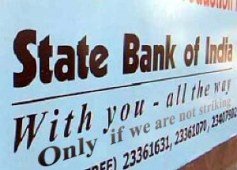 On Tuesday, when the country's largest bank - State Bank of India - raised lending rates by 75 basis points, many were surprised.
On Tuesday, when the country's largest bank - State Bank of India - raised lending rates by 75 basis points, many were surprised.The reason: The sharp increase was a major departure from those during former chairman O P Bhatt's regime.
Last October, after the Reserve Bank of India affected successive rate increases, forcing all major banks to raise their base rates by 50 bps, SBI had raised its rates by a symbolic 10 bps, even as it already had the lowest base rate.
Pratip Chaudhuri and O P Bhatt are a study in contrast. When Bhatt took charge as the SBI chairman in 2006, his priority was regaining market share, for which he created a detailed road map.
The plan worked well and the bank has, in the last three-and-a-half years, raised its market share 125 bps in loans and 200 bps in deposits.
Besides, SBI was always the last to increase interest rates and, even so, it ensured borrowers' additional burden was minimal.
As a result, even in a hardening interest rate market, SBI kept its home loan rate unchanged for almost two years.
Chaudhuri, on the other hand, wants to catch up on a number of other parameters.
Tuesday's 75 bps base rate increase is a testimony to that.
In the one month since Chaudhuri has taken over, SBI has raised lending rates by 100 bps.
And, the controversial fixed teaser rates have already been replaced with floating rates, following discussions with RBI.
One of the main pillars of SBI's strength is very high current and savings deposits that are low-cost deposits.
At 48.17 per cent, SBI's Casa is less than only that of HDFC Bank, which is of a much smaller size.
For a bank of a balance sheet size of nearly Rs. 7.5 lakh crore, the high level of Casa gives huge comfort when it comes to making difficult decisions like raising lending rates.
Historically, SBI always kept its lending rate at the lowest and deposit rate at the highest level.
The bank was always mindful of the margin it maintained with its competitors and always kept it at 25-50 bps.
In July, when the base rate regime came into force, the differential between SBI's rate was 50 bps lower than other public sector banks.
But in the next few months and after several rate increases from the apex bank, this differential rose to 150 basis points.
Clearly, SBI was in no mood to aggressively raise rates.
Though the net interest margin did not suffer hugely (at 3.4 per cent in December), it dropped to its lowest in six years, at 2.66 per cent in 2009-10.
The bank, as a result, is being more cautious now.
The present management is working towards maintaining the net interest margin at a healthy level.
According to a senior SBI executive, the sharp increase in lending rate is primarily due to two reasons.
First, it is in response to a more-than-expected rate increase by RBI during the annual monetary policy, in which key policy rates were raised 50
bps.
The second reason was to protect margins.
"Improving margins is one of the main objectives of the bank in the current financial year, K Krishna Kumar, managing director of SBI, said in a recent interview to Business Standard.
An executive of the bank said: "The full effect of the deposit rate increases will be felt in this quarter. The base rate rise was required to protect margins.
"The revision in BPLR and base rate (75 bps) will improve margins by 3-4 bps. About 55 per cent of total loan book is still linked to BPLR."
Analysts are also quite happy with the recent increase because they feel, since the bank's cost of funds is among the lowest in the industry, this increase will positively affect margins and lead to an earnings upgrade.
"But we are not sure if the positives will be reflected in one quarter or over the next two quarters," said an analyst with a domestic broking firm.
Return on asset is another area that the new management is working on.
"Return on Assets for most banks is 1.20-1.25 per cent while ours is close to 1 per cent (0.96 per cent).
"The focus is to improve our efficiency," another executive of the bank said.
In 2009-10, RoA had fallen sharply to 0.88 per cent from 1.04 per cent.
Improving the state of non-performing assets, especially loans disbursed to retail and small-and medium-enterprises, is also seen as a huge challenge the present management faces.
SBI officials say monitoring and follow-up to these sectors will be beefed up.
Besides the financial parameters, improving relationship with RBI is also in the agenda for the new management.
Chairman Chaudhuri had made it clear within a week of taking charge.
Withdrawal of teaser rates, even though it helped the bank gain market share, was affected after the new management met RBI officials.
The bank is staring at higher provisioning of Rs. 600 crore (Rs. 6 billion), which it is seeking to be waived by the regulator.
On meeting the provision coverage ratio requirement of 70 per cent, the recent regulatory dispensation is expected to benefit SBI the most.
SBI, which was given extension in the deadline, now says they can meet the norms within the time given to them by RBI.
Even the organisation structure may be changed. The bank had scrapped one layer in decision making - which was headed by the deputy general manager - in the circles.
The removal of the layer was done to expedite the pace of decision making. But it raised pressure on general managers without cutting on decision time.
These measures are expected to be implemented after the bank finalises its financial results for 2010-11.











